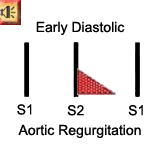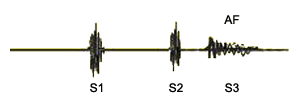
DIASTOLIC MURMURS: occurs during resting phase
- Occurs during refilling atria
- Heard between S2 and S1
- Examples:
- Mitral stenosis (MS)
- Aortic regurgitation (AR)




|
|
 |
 |
 |
|
|
||||
Having trouble remembering which murmurs are systolic and which are diastolic?
- Think of Ms. Ard and Mr. Pass !
Ms. Ard - Mitral stenosis (Ms), aortic regurgitation (Ar) are diastolic (d)
Mr. Pass - Mitral regurgitation (Mr), physiologic (P) and aortic stenosis (as) are systolic (s)
|
||||||||||||

